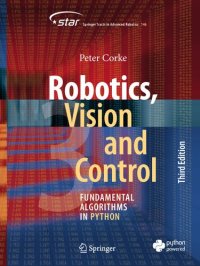
Ebook: Robotics, Vision and Control: Fundamental Algorithms in Python, 3rd Edition
Author: Peter Corke
- Genre: Computers // Algorithms and Data Structures: Pattern Recognition
- Tags: Algorithms, Robotics, Computer Vision, Python, Control Theory
- Series: Springer Tracts in Advanced Robotics
- Year: 2023
- Publisher: Springer
- Edition: 3
- Language: English
- pdf
This textbook provides a comprehensive, but tutorial, introduction to robotics, computer vision, and control. It is written in a light but informative conversational style, weaving text, figures, mathematics, and lines of code into a narrative that covers robotics and computer vision―separately, and together as robotic vision. Over 1600 code examples show how complex problems can be decomposed and solved using just a few simple lines of code.
This edition is based on Python and is accompanied by fully open-source Python-based Toolboxes for robotics and machine vision. The new Toolboxes enable the reader to easily bring the algorithmic concepts into practice and work with real, non-trivial, problems on a broad range of computing platforms. For the beginning student the book makes the algorithms accessible, the Toolbox code can be read to gain understanding, and the examples illustrate how it can be used. The code can also be the starting point for new work, for practitioners, students, or researchers, by writing programs based on Toolbox functions, or modifying the Toolbox code itself.
The first two editions of this book were based on MATLAB in conjunction with open-source MATLAB Toolboxes that are now thirty years old – that’s a long time for any piece of software. Much has happened in the last decade that motivate a change to the software foundations of the book, and that has led to two third editions: The version you are reading, is based on Python which is a popular open-source language with massive third party support. The old MATLAB Toolboxes have been redesigned and reimplemented in Python, taking advantage of popular open-source packages and resources to provide platform portability, fast browser-based 3D graphics, online documentation, fast numerical and symbolic operations, shareable and web-browseable notebooks all powered by GitHub and the open-source community.
The computational foundation of this book is Python 3, a powerful and popular programming language that is likely to be familiar to students, researchers and hobbyists. The core functionality of Python can be extended with packages that can be downloaded, installed and then imported. Python, combined with popular packages such as NumPy, SciPy and Matplotlib provides a powerful interactive mathematical software environment that makes linear algebra, data analysis and high-quality graphics a breeze. Functionality for robotics and computer vision is provided by additional easily-installable packages.
This edition is based on Python and is accompanied by fully open-source Python-based Toolboxes for robotics and machine vision. The new Toolboxes enable the reader to easily bring the algorithmic concepts into practice and work with real, non-trivial, problems on a broad range of computing platforms. For the beginning student the book makes the algorithms accessible, the Toolbox code can be read to gain understanding, and the examples illustrate how it can be used. The code can also be the starting point for new work, for practitioners, students, or researchers, by writing programs based on Toolbox functions, or modifying the Toolbox code itself.
The first two editions of this book were based on MATLAB in conjunction with open-source MATLAB Toolboxes that are now thirty years old – that’s a long time for any piece of software. Much has happened in the last decade that motivate a change to the software foundations of the book, and that has led to two third editions: The version you are reading, is based on Python which is a popular open-source language with massive third party support. The old MATLAB Toolboxes have been redesigned and reimplemented in Python, taking advantage of popular open-source packages and resources to provide platform portability, fast browser-based 3D graphics, online documentation, fast numerical and symbolic operations, shareable and web-browseable notebooks all powered by GitHub and the open-source community.
The computational foundation of this book is Python 3, a powerful and popular programming language that is likely to be familiar to students, researchers and hobbyists. The core functionality of Python can be extended with packages that can be downloaded, installed and then imported. Python, combined with popular packages such as NumPy, SciPy and Matplotlib provides a powerful interactive mathematical software environment that makes linear algebra, data analysis and high-quality graphics a breeze. Functionality for robotics and computer vision is provided by additional easily-installable packages.
Download the book Robotics, Vision and Control: Fundamental Algorithms in Python, 3rd Edition for free or read online
Continue reading on any device:

Last viewed books
Related books
{related-news}
Comments (0)